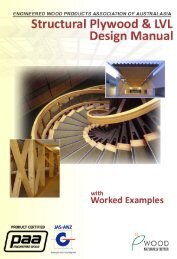Facts About Particleboard and MDF - Engineered Wood Products ...
Facts About Particleboard and MDF - Engineered Wood Products ...
Facts About Particleboard and MDF - Engineered Wood Products ...
Create successful ePaper yourself
Turn your PDF publications into a flip-book with our unique Google optimized e-Paper software.
Machining, Jointing <strong>and</strong> Fixing<br />
This sheet describes basic principles of machining <strong>and</strong> fixing <strong>Particleboard</strong> <strong>and</strong> Medium Density Fibreboard<br />
(<strong>MDF</strong>). Any specific requirements related to a particular end use are dealt with in the relevant Installations<br />
<strong>and</strong> Applications sheets.<br />
<strong>Particleboard</strong> <strong>and</strong> <strong>MDF</strong> are simply worked with normal woodworking tools. The uniform <strong>and</strong> consistent<br />
character of the material coupled with a non-directional grain, allows conventional techniques <strong>and</strong> machines<br />
to be readily <strong>and</strong> economically applied with constant results. Precision techniques are best suited to the<br />
machining of these wood panels <strong>and</strong> when extended to jointing <strong>and</strong> assembly the user will derive the<br />
greatest advantage from the use of the material.<br />
Machining<br />
<strong>Particleboard</strong> <strong>and</strong> <strong>MDF</strong> can be sawn, routed, spindled, planed or bored. The rate of feed should generally be<br />
slower than that used for natural timber <strong>and</strong> cutting edges should be kept thoroughly sharp. This is<br />
particularly important in the case of plastic laminate-faced boards as otherwise the edges may bell or spread<br />
slightly.<br />
Sawing - Plain <strong>Particleboard</strong> <strong>and</strong> <strong>MDF</strong><br />
As the grain direction of the wood particles <strong>and</strong> fibres in <strong>Particleboard</strong> <strong>and</strong> <strong>MDF</strong> are of a r<strong>and</strong>om pattern, saw<br />
blades with cross-cutting tooth forms should be used.<br />
H<strong>and</strong>ling During Sawing<br />
Control over the board during machining is important; boards should be properly supported <strong>and</strong> pressed<br />
down firmly against the cutting table <strong>and</strong> guides to avoid vibration. The most satisfactory results will be<br />
obtained with a constant rate of feed which should not exceed 23 m/mm. Generally mechanical feeding,<br />
though not essential, is recommended. Because of the difficulty in adequately controlling long boards, a<br />
travelling saw will often produce a more satisfactory result.<br />
The projection of the saw above the board has a direct influence on the cleanliness of the cut. Breaking out or<br />
chipping of the top surface will occur if it is insufficient <strong>and</strong> on the bottom surface if it is too great. If either<br />
occurs, the projection should be adjusted accordingly until the defect disappears. If the fault persists, the saw<br />
speed should be increased or the rate of feed reduced.<br />
Saws<br />
For small quantities of intermittent use, any of the normal h<strong>and</strong> or power tools can be used with satisfactory<br />
results. An aluminium cutting saw blade, 175-250mm diameter, is recommended by one of the major power<br />
tool manufacturers. For quantity production, any of the conventional machines used for cutting natural<br />
timber are suitable. Tungsten-carbide cutting edges are recommended as they will have at least 20 times the<br />
cutting life between sharpenings of a high-speed steel blade <strong>and</strong> should be capable of about 30 sharpenings<br />
before the teeth are worn out.<br />
Circular blades should be 355mm with 60 teeth <strong>and</strong> have a peripheral saw speed of 3000-3350 metres/min.<br />
Teeth angles are important <strong>and</strong> particularly the need for a positive front angle. The diagram below shows the<br />
recommended details:<br />
The saw blade should rotate in the opposite direction to the feed <strong>and</strong> a riving knife should be fitted to open<br />
the cut.<br />
23

















